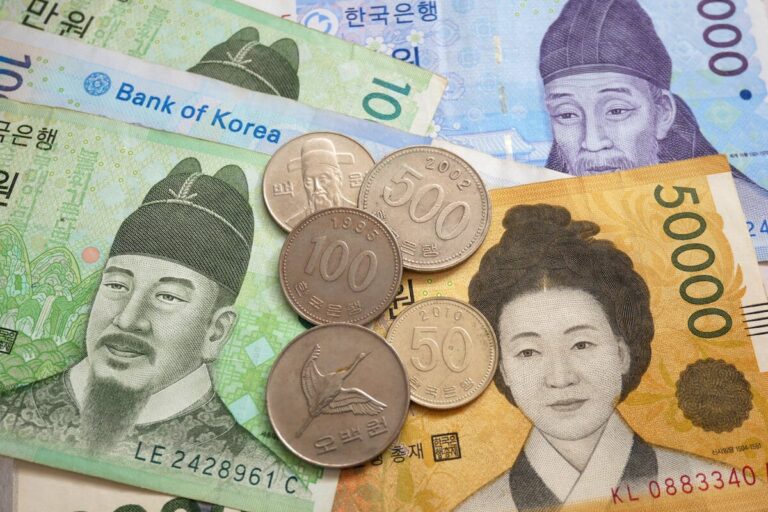Are you planning a trip to South Korea or want to send money to loved ones there? Knowing about the Korean won, which is the country’s main currency, can make your trip better and help you make good money choices. The won is more than bills and coins. It has a story full of strength, cultural pride, and big changes in the economy. If you are trading money for travel, want to know about Korea’s past with money, or are just curious about how the world uses different coins and notes, these facts about the South Korean won will help you learn something new.
1. Etymology: A Blend of ‘Yuan’ and ‘Yen’
The word “won” has the same language roots as the Chinese “yuan” and the Japanese “yen.” All these words come from one word that means “round.” They are called this because old coins were round in shape. This name shows how Korea’s money system has been shaped by other nearby countries in the past.
2. Banknotes Feature Prominent Historical Figures
South Korean banknotes show some people from the Joseon Dynasty who are important.
- ₩1,000: Yi Hwang was a well-known Confucian teacher.
- ₩5,000: Yi I was another famous thinker in Confucian teaching.
- ₩10,000: King Sejong the Great made the Korean alphabet, Hangul. He is greatly honored.
- ₩50,000: Shin Saimdang was an artist and the mother of Yi I. She stands for the role of women in Korean history.
3. Advanced Security Features Combat Counterfeiting
South Korea had some problems with fake money, mostly with the ₩5,000 note in the early 2000s. Because of this, the country brought in new banknotes. These banknotes have better security features.
- 3D holograms that can change color.
- Watermarks that show detailed faces.
- Microprinting and ink that change color.
Coins also use special materials to stop fake making of them.

4. Material Shift in Coinage Due to Economic Factors
The ₩1 coins were first made from brass. But in 1968, the cost of brass went up, so these coins started to be made out of aluminum instead. Aluminum was cheaper to use and easier to get.
5. Evolution Through Historical Turbulence
The won has undergone several transformations:
- The yen was used during the Japanese occupation from 1910 to 1945.
- After gaining independence in 1945, South Korea started to use the won. At first, one US dollar was equal to 15 won.
- The country faced economic problems, like the Korean War. This made the value of the won go down several times.
- The Bank of Korea started in 1950. By 1975, the KRW became the only official money in South Korea.
6. The Bank of Korea: Guardian of the Won
The Bank of Korea started in 1950. It replaced the Bank of Joseon. The Bank of Korea began to issue new bills and manage the country’s money policy. It is very important in keeping the South Korean money system steady and honest.
Understanding the Value of the Korean Won
South Korea grew a lot between the 1960s and the 1990s. This helped the country become rich and made the won, its money, stronger. But things have changed in the world, especially after the COVID-19 outbreak, and this has caused ups and downs in the market. Reuters+1Reuters+1
As of May 2025, the exchange rate is about 1 US dollar to 1,386.6 Korean won. The won is getting stronger now. This is because of things like changes in U.S. money rules and how well the South Korean economy is doing. Reuters
Exchanging and Sending Money to South Korea
When traveling to South Korea or sending money:
- Currency Exchange: You can get this done at airports, banks, and places that are allowed to do exchanges.
- ATMs: These are easy to find and use; make sure your card will work in other countries.
- Money Transfer Services: Places like Remitly often have good rates and make it easy to send money.
- Make sure to always look at the exchange rates and fees. This way, you can get the best value for your money.
Frequently Asked Questions
What denominations are available in South Korean currency?
- Banknotes: ₩1,000, ₩5,000, ₩10,000, ₩50,000.
- Coins: ₩10, ₩50, ₩100, ₩500.
Is the South Korean won accepted outside of South Korea?
Generally, the won is not accepted outside South Korea. It’s advisable to exchange any remaining won before leaving the country.
How can I get the best exchange rate when converting to won?
Monitor exchange rates through reliable financial news sources. Avoid exchanging money at airports, where rates may be less favorable. Consider using reputable online platforms or local banks.

